Reading about space to babies can significantly benefit their cognitive and imaginative development. Introducing them to concepts like planets, stars, and the vastness of the universe can help broaden their understanding of the world beyond their immediate environment. Colorful illustrations and simple narratives about space in children’s books can stimulate visual learning and curiosity. Additionally, early exposure to scientific vocabulary and ideas lays a foundation for future learning in science and encourages a lifelong interest in exploring and understanding complex concepts. These reading experiences not only enhance language skills but also foster a sense of wonder and exploration, crucial elements in the early stages of development.
“Hello, World! Solar System” by Jill McDonald (Published 2016)
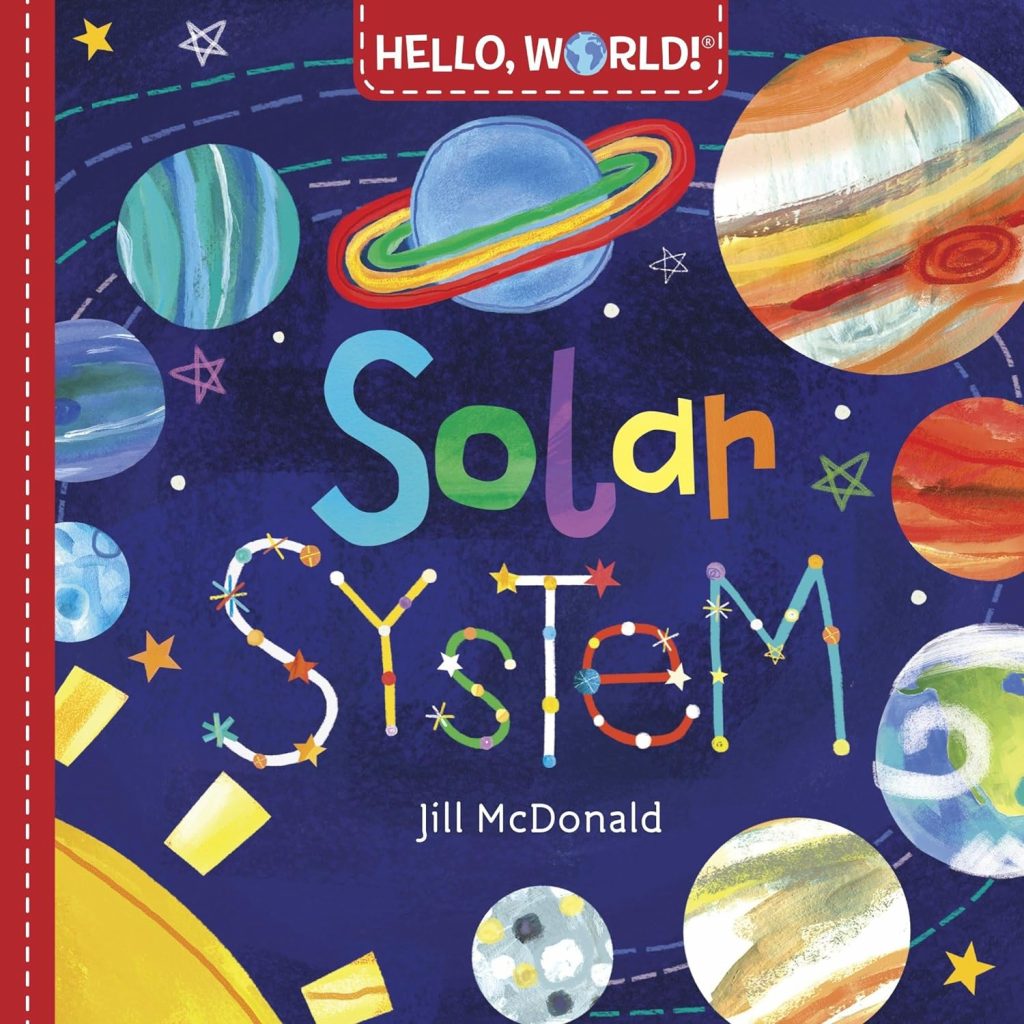
Part of the “Hello, World!” series designed to introduce basic concepts to toddlers, this book provides a simple and engaging introduction to the solar system. It covers key celestial bodies, including the sun, moon, stars, and planets, using bright, bold illustrations and straightforward text to explain each one’s unique features.
It presents complex information about space in a way that is easy to understand and visually appealing. The format is interactive, with questions and prompts that encourage children to observe and think about the world around them. This stimulates early learning and curiosity about science and astronomy.
“Hello, World! Solar System” is well-suited for young readers because of its clear, repetitive language and the durable, easy-to-handle board book format, making it practical for repeated use by little hands.
“Baby Loves Aerospace Engineering!” by Ruth Spiro (Published 2016)
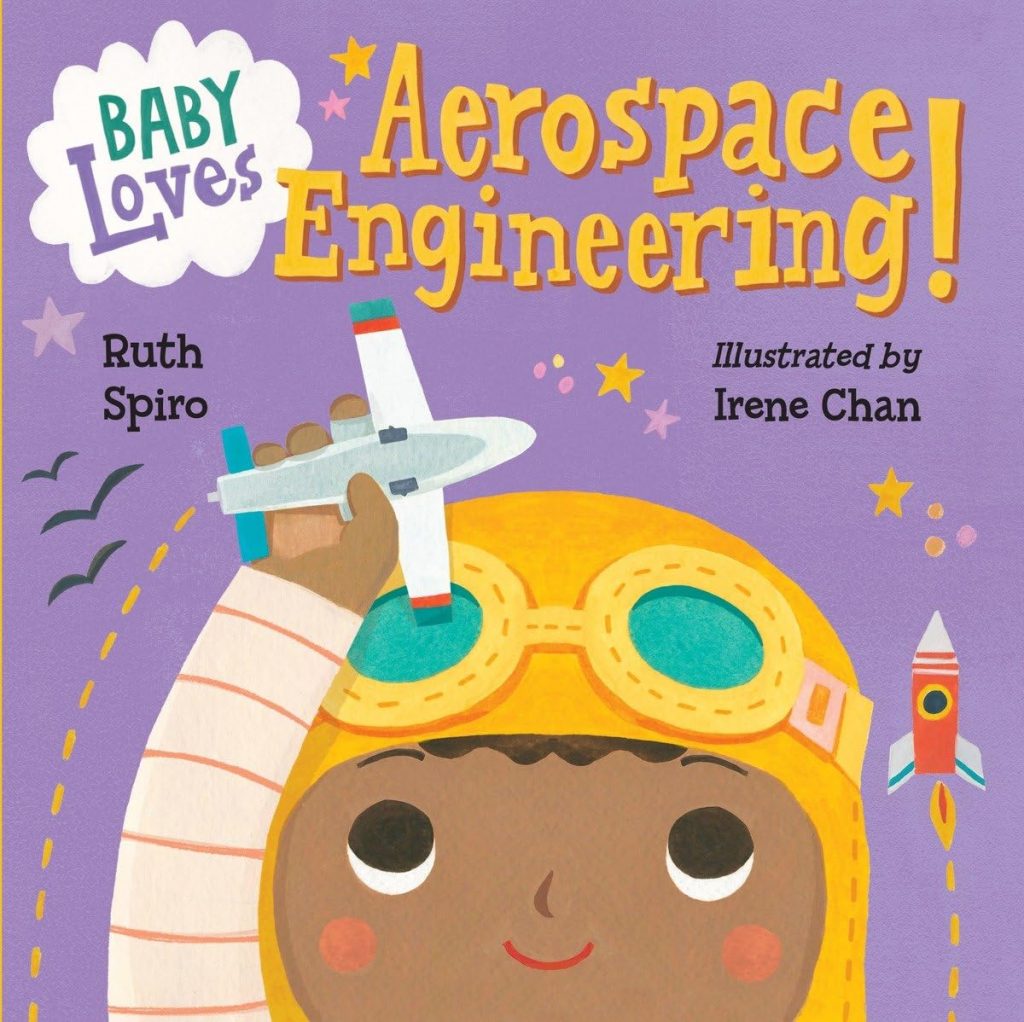
This engaging book is part of the “Baby Loves Science” series, which introduces complex scientific concepts in a way that’s accessible and enjoyable for very young children. In this installment, the book explains the basics of aerospace engineering, including how birds fly and how airplanes and rockets defy gravity to travel through the sky and into space.
The book is excellent reading material for babies because it simplifies the principles of flight and space travel through clear, concise text and vibrant, colorful illustrations. It introduces young readers to scientific vocabulary and foundational physics concepts, fostering early interest and understanding in science and engineering.
What makes “Baby Loves Aerospace Engineering!” stand out is its ability to make a complex subject like aerospace engineering understandable for toddlers. It lays the groundwork for critical thinking and curiosity about how things work in the simplest terms, which is key in early development stages. This book is ideal for parents and educators who want to instill a love of science in children from a very young age.
“8 Little Planets” by Chris Ferrie (Published 2018)
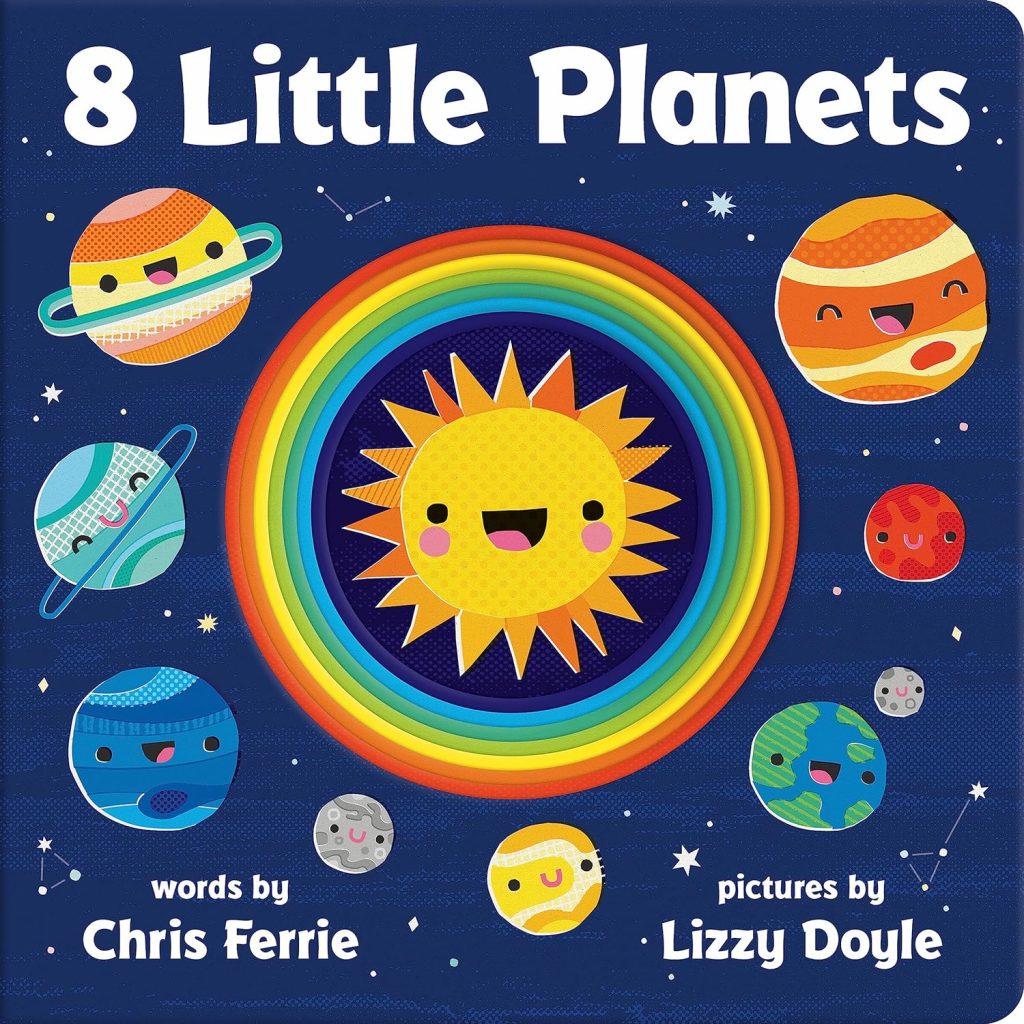
The book features a charming rhyming story that introduces young readers to the planets of our solar system. Each planet is described with unique characteristics and is accompanied by adorable, colorful illustrations that capture the essence of each celestial body.
The book is excellent reading material for young children because it combines educational content with engaging visuals and catchy rhymes. This approach not only makes learning about the planets fun but also aids in memory retention and language development. “8 Little Planets” introduces basic concepts of astronomy in a way that is accessible and enjoyable for toddlers and preschoolers.
Additionally, the book is interactive, with die-cut shapes that add a tactile element to the reading experience. This feature makes it particularly appealing to young children, encouraging them to engage more deeply with the content.
“Moon Landing” by Jill McDonald (Published 2019)

The book explains the basic concepts of the mission to space, from the astronauts boarding the rocket to landing on the moon and returning to Earth. It’s crafted with simple, straightforward language and features vibrant, colorful illustrations that capture the excitement of space exploration. This combination makes the book engaging and easily understandable for young children.
“Moon Landing” is an excellent reading material because it not only educates children about a significant historical event but also encourages curiosity about science and space. The book includes interactive elements such as lift-the-flap surprises, which add an engaging tactile component to the reading experience. These features make the learning process interactive and fun, helping to maintain the attention of young readers and promote an active engagement with the content.
“Goodnight Spaceman” by Michelle Robinson (2016)

Inspired by astronaut Tim Peake and his missions, the book is part of the “Goodnight” series that captivates young readers with nighttime adventures. The story features two little boys who are fascinated by space and imagine themselves as astronauts saying goodnight to all the sights and experiences of space travel.
The book effectively uses the theme of space to craft a bedtime story that is both educational and soothing. The narrative includes elements like rocket ships, planets, and stars, making it a delightful journey through the cosmos right before bedtime. The rhythmic text and the soothing pace make it an ideal bedtime read.
What makes “Goodnight Spaceman” a great reading material for young children is its ability to blend facts about space with a dreamy, adventure-filled narrative that stimulates imagination and curiosity about the universe. The illustrations by Nick East are vibrant and playful, perfectly complementing the story’s atmosphere. The book also includes a letter from Tim Peake, adding a personal touch that connects the story to real-life space exploration.
“My First Book of Planets: All About the Solar System for Kids” by Bruce Betts (Published 2020)

This educational book is designed to introduce young children to the wonders of our solar system. It covers each planet in detail, providing facts about their environments, orbits, and unique features. The book is filled with colorful illustrations and simple, engaging explanations that make the vast concepts of space more accessible to kids.
The book excels as reading material for children because it breaks down complex astronomical information into bite-sized, easy-to-understand pieces. It uses clear, concise language that is suitable for young readers, along with fun facts that keep them engaged and eager to learn more. The book also includes a glossary of terms to help expand the vocabulary of young readers in the context of space and astronomy.
“My First Book of Planets” is a great resource for sparking curiosity about the universe. It serves as an excellent introduction to space science for young children, encouraging them to explore further and develop an interest in science and the natural world.
“Baby University Four-Book Set” by Chris Ferrie (Published 2017)

This set includes board books that simplify complex scientific and mathematical concepts for very young readers. Among these, “Rocket Science for Babies” and “Astrophysics for Babies” are specifically related to space, introducing basic principles of aerospace engineering and the fundamentals of the universe.
These books are excellent reading materials for babies and toddlers due to their clear, simple explanations paired with bold, graphic illustrations that help in visual learning. Chris Ferrie, who is both a physicist and a mathematician, uses a straightforward approach that makes abstract scientific concepts accessible to young minds. This early introduction to scientific vocabulary and ideas prepares children for future learning and sparks early interest in science and technology.
The “Baby University” books are particularly noteworthy for their unique premise: teaching complex subjects to the youngest of audiences. This approach not only entertains but also educates, making learning fun and interactive. The series has been praised for its innovative method of bridging educational content with early childhood learning, making it a popular choice among parents and educators seeking to cultivate a curiosity about the world from a very early age.
“Space Walk” by Salina Yoon (Published 2008)

This interactive lift-the-flap book takes young readers on a journey through the solar system, visiting planets, the moon, and stars along the way. The book is structured around a simple narrative of a space walk, where each page reveals new facts and sights of outer space through engaging flaps that children can lift.
The book’s educational value lies in its ability to introduce basic astronomical concepts in a highly interactive and engaging format, which is perfect for holding the attention of young children. The use of flaps not only makes the reading experience more enjoyable but also enhances motor skills as children practice lifting and exploring the hidden elements on each page.
“Space Walk” is excellently suited as reading material for preschoolers because it combines simple, clear text with colorful and bold illustrations that vividly bring the cosmos to life. Its interactive nature makes it more than just a reading experience—it’s also a playful activity that encourages learning through discovery.
“Roaring Rockets” by Tony Mitton (Published 2000)
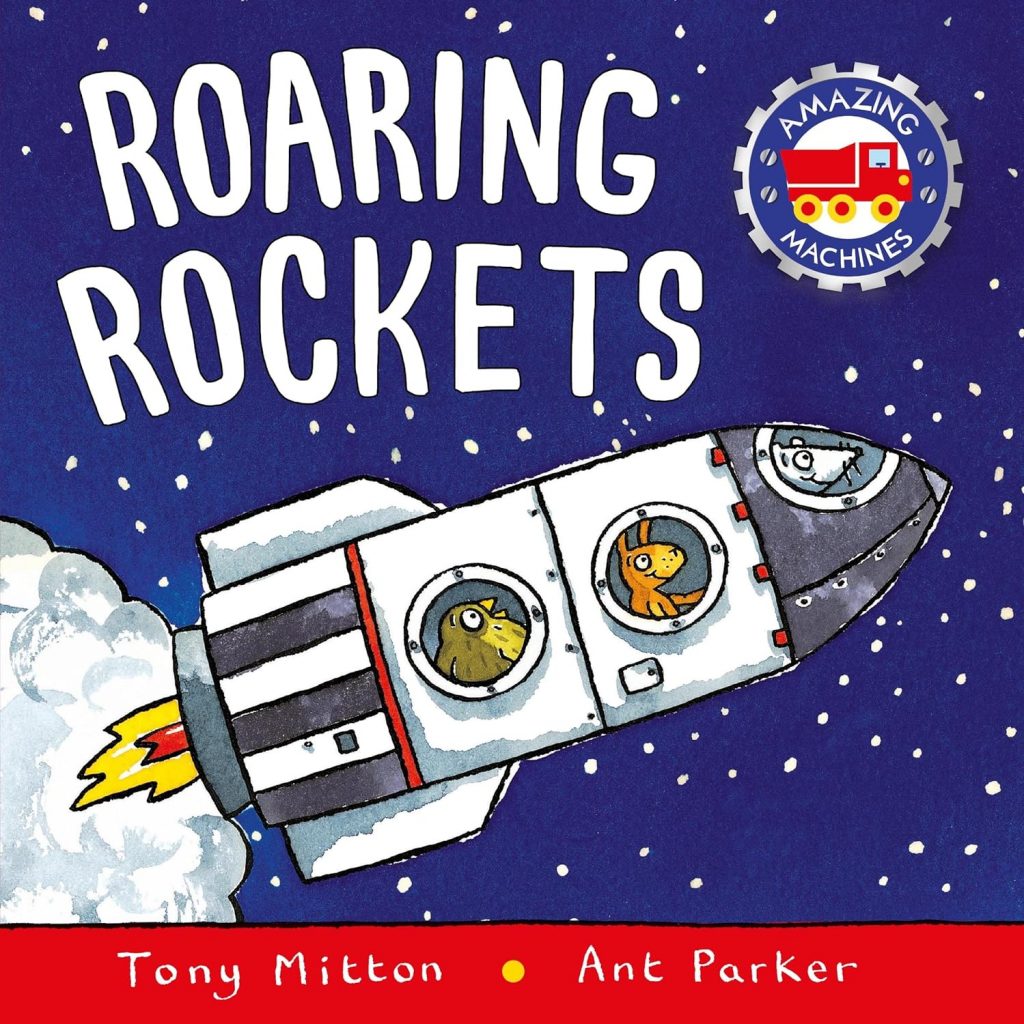
The book is a rhyming story that introduces young readers to the exciting world of rockets and space travel. It follows a group of animal astronauts as they prepare for a journey to the moon, providing basic information about how rockets work, the experience of liftoff, and what it’s like to walk on the moon.
The book is particularly effective as reading material for young children because of its engaging rhyme scheme and lively, colorful illustrations. These elements make the scientific content approachable and fun, capturing the imagination of young readers and fostering an early interest in science and technology. The rhythmic text not only makes the reading experience enjoyable but also helps in language development by introducing new vocabulary in a memorable way.
“Roaring Rockets” is also educational, as it includes a glossary at the end of the book that explains the terms used throughout the story, helping to deepen children’s understanding of the concepts introduced. This combination of fun storytelling, vibrant illustrations, and educational content makes it an excellent choice for young children curious about rockets and space exploration.
“Zoom, Zoom, Baby!” by Karen Katz (Published 2014)
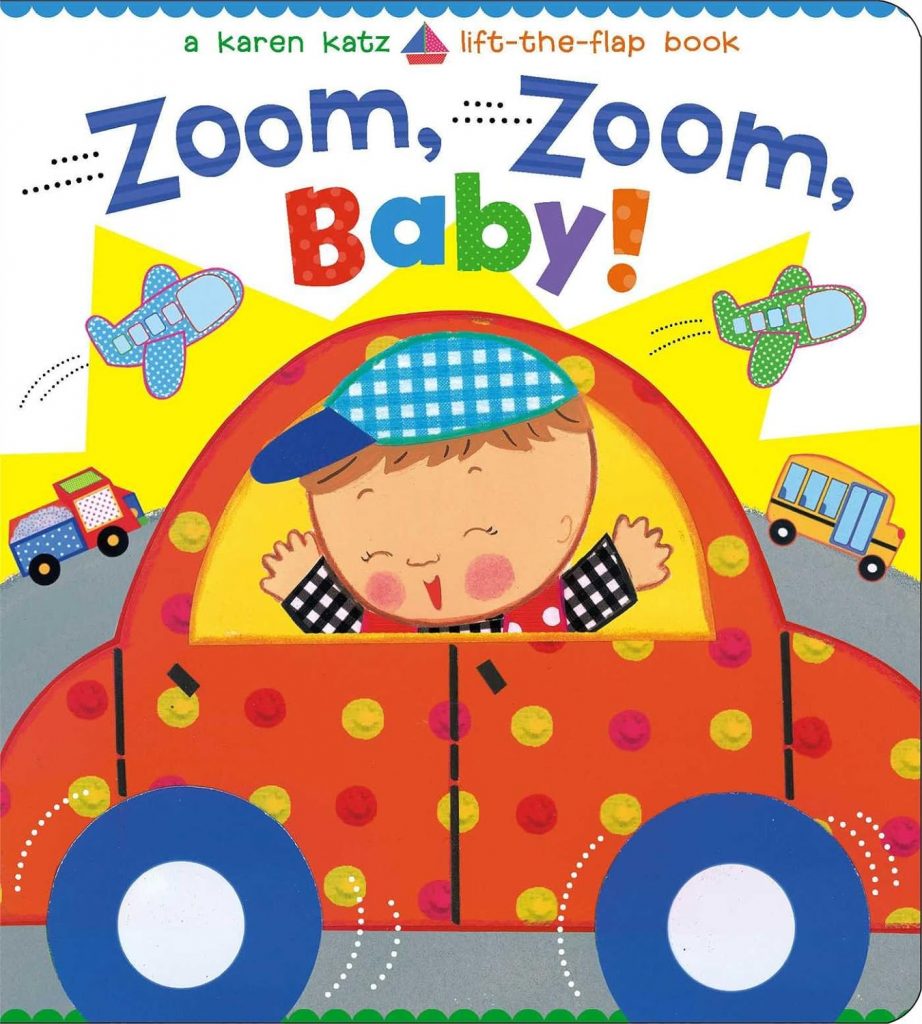
This is a lift-the-flap board book that is part of Karen Katz’s series of interactive books for babies. While the book primarily focuses on various vehicles and modes of transportation, it includes a fun surprise about space travel towards the end.
The book isn’t exclusively about space, but it engages young children through its playful, interactive format where they can lift flaps to discover different vehicles, including a rocket ship. This element introduces babies to the concept of space travel in a simple and exciting way.
“Zoom, Zoom, Baby!” is an excellent reading material for very young children because of its bright, colorful illustrations and easy-to-understand language. The interactive flaps enhance fine motor skills and keep children engaged by allowing them to explore and find surprises on their own. The repetitive and rhythmic text also helps in developing early literacy skills.
This book is particularly appealing due to its playful approach to learning about transportation, making it a delightful addition to a baby’s first library, offering both entertainment and educational value.
Leave a Reply